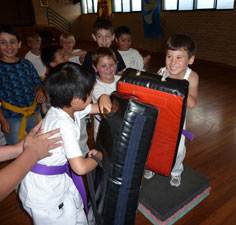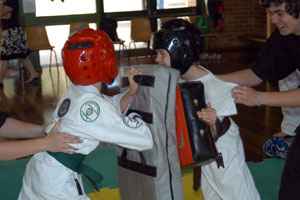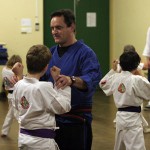By guest author Matt Klein

Many martial arts schools teach children as a sidelight to their main focus: adults. They are not that interested in children, and only do it because it represents a sizable chunk of their school’s income. Children are routinely thrown into adults classes or treated as “miniature adults.” A school that can focus on the needs of children will be very successful, as there are few that get it right. To be a successful martial arts school for children, it is important to recognize how teaching them differs from the teaching of adults.
Cognitive differences
The attention span of a child is much shorter than that of an adult. You must break the class into smaller segments, with more varied activities than an adults class. Games should be played to build fitness and martial arts skills, and to have fun at the same time. Otherwise, the children will get bored. The class itself will be shorter. The number of repetitions for each technique will be less than an adults class. Ten repetitions is a good rule of thumb.
The perception of time differs greatly between an adult and a child. Waiting six months for the next grading and belt seems like forever to a child. It is better to break up the belts into chunks such as degrees or stripes and grade them more frequently to encourage them to work toward their goals.
The differences in cognitive ability have a great impact on how to teach a child. You must ditch the big words to make it easy to for them to understand you. For instance, “back knuckle” is difficult for a child to say. “Back fist” is better. Wordy explanations of the techniques and theory will only bore children. The techniques must be demonstrated visually and broken down into the most basic steps.
With children it is much more important to emphasize the need for self defense only. An adult understands when it is appropriate to use martial arts skills. With children, you really need to stress that it is not ok to solve our problems with force. If this comes from a positive role model, children take it to heart.
Capacity for exercise
Stretching excessively is not good for small children. Five to ten minutes is enough. They are naturally more limber than adults. Make the stretches fun by having the kids imitate certain animals, including their sounds. Doing excessive exercises, like push ups or sit ups is not appropriate for children either. If you make them do dozens of push ups, you will lose most of your students. Doing a few is OK.
Discipline
It is hard to discipline an adult for disrupting a class. Some try push ups or other exercises, but I don’t believe exercise should be used as punishment. People should want to do it and feel good about it. If you cannot reason with an adult who is disruptive or has a bad attitude, simply ask them to leave. A child can be sat down if they need it. They hate inactivity, especially if other kids are playing. It is very effective.
Adults come to class because they want to be there. Be aware that some children are there because they have no choice. If you sense that a child does not want to be there, try hard to encourage them. I don’t think it is a good idea to force a child to do any activity, but I have had many students, now black belts, who told me they are glad their parents pushed them into it. I can see both sides of the story.
Expect kids to be brutally frank, unlike adults. I’ve had children ask me “did you put on weight”, “did you dye your hair”? Children put up their hands and announce to the class “Jack here next to me just farted.” You just have to laugh.
Sparring classes

When children are sparring, you need to supervise them much closer than adults. They do not usually have the same level of physical and mental control as an adult. They can lose control of their emotions, get angry, and hurt each other. Letting them do competition sparring, like point sparring with light contact, is great because it is like a game. Kids love games. Spar with your students, show them a few moves, then let them score on you with the moves. This will build their confidence greatly.
Motivation
If you bend down and talk to them at their level, children understand and relate better to you. If you get down and do the exercises with them, they will respond. Children can sense your passion and interest. Let your personality and energy come out. Kids love to make loud noises, it is a great release for them–let them yell. Say “I can’t hear you,” and get them going. Have competitions between different parts of the class to see who has the loudest kiai.
You cannot teach from the front of the room. This is especially true with kids. You must get around to each student, give them encouragement, sometimes moving their arms and legs for them to give them the idea. They can learn from muscle memory if you physically show them the correct motion.

Positive reinforcement works wonders with children. “Good job”, “well done”, excellent kick”, should be said many times during a class. When correcting a child, use a positive word after the correction, such as “bring that knee up higher and your kicks will be even better; good job.”
Children: The future of martial arts
Embrace children in your classes–they are your future, and the future of martial arts. One day, one of them will be running your classes.
About the Author: Matt Klein has trained in the martial arts for over twenty years, studying Judo, boxing, wrestling, Jujitsu, MMA (Mixed Martial Arts), Kali and American Kenpo Karate. Matt founded the first club specializing in martial arts for kids in Australia, and he now has 11 locations in the Sydney area. Matt blogs at Martial Arts for Kids.
This is why I love the school we put my son into. The school focuses on the children to the point of offering after school and summer day camp programs. All the instructors try to talk to the children at their level. The class get broken into very small groups, and I have seen all the instructors try to give individual to each student in the group. They tend to focus on this especially with the 3-5 year old beginner students and it’s just great.
Thanks for your insights Liam. It sounds like you have made a wise choice in your selection of schools. The really good ones are hard to find. The summer day camp programs are something we have not provided, but would definitely consider. Would be interested in hearing your feedback on them.
The martial arts is a wonderful building block for kids, I might even say a cornerstone to a great outlook on life. Everyone needs to learn some form of martial art. It would change the world.
The August issue of No Way Net Magazine is unbelievable. Check it out and then tell me I’m wrong.
http://www.1ancientwon.com/no_way_net_magazine/no_way_net_mag.html
You’re welcome Matt. The way my son’s school treats the children, and the focus they put on teaching respect and manners are what won my wife and I over to that particular school. BTW, it’s Hwang’s Martial Arts run by Grandmaster Jung Oh Hwang. I highly recommend to the school to anyone in the Louisville, KY area.
J. Simmons, thanks for the comments. Your statement about “changing the world” is not an exaggeration. I have seen how prejudice and racism are stopped dead in their tracks, at least in the martial arts world. In the training place we are all brothers and sisters, doing our best to help each other.
As always, a great article Matt. Thank you for sharing and your inspiration
Working with children requires a LOT of patience. It’s a whole different game than working with adults. I’ve heard instructors say in adult classes “You guys are so great, you always listen” and that’s only because they’ve been through 2 previous children classes. With that said, the positive impact that Martial Arts has on a child is incredible, almost every aspect of their life improves as a result.
Also, I’ve trained at a Dojo that had children and adult belt tests ANUALLY. You mention in the article that 6months is a lot, imagine a year…
Thanks for the article Matt, very detailed.
Hi Ivana! great to see the Kenpo tribe here. Thanks for your support.
Dojo Reviews, I left that one out. Thank you very much, that is a great point. Kids learn slower and they get distracted so, yes, you need the patience of Job.
Great article, Matt!
Wow, you really have a comprehensive understanding of children and how they learn. And this post was organized well by breaking it down into easy to read sections.
I don’t teach martial arts myself, but I think that anyone who teaches children would benefit from reading this post and as a result so would their students!
Thanks Andrew. I appreciate your comments. I tried to make it as well organized as I could, considering the teaching of children can sometimes be classified as “mass chaos.”
Very insightful article, Matt.
Again, you have confirmed your established position as an authority and a go-to guy in the field of teaching martial art to kids.
Keep up the awesome work.
Thanks for your vote of confidence Martial Arts Reporter. It is great to get a little recognition from my peers, especially ones like yourself. Cheers.
This is fundamentally the same as the techniques that are used at the karate school where I work. Good advice.
Very nice article Matt,
Teaching Children, I have learned that the classes are a living thing. Sometimes they don’t go completely to plan – the instructor needs to be passionate (as you have mentioned) and “in it” so if things need to be changed or adjusted to get a better response on the day the instructor can do that & keep their attention.
I completely agree, above all with children – Fun = Success.
I personally love watching the Children grow into fine young adults. Having a positive impact when they are so young really helps their mature state of mind and sense of worth, self and otherwise.
Once again very nicely put, highly informative AAA+++
I especially like you last paragraph;
“Embrace children in your classes–they are your future, and the future of martial arts. One day, one of them will be running your classes”
Thanks Keith, it is good to see others follow the same philosophy. It is a winning formula for us.
Zoltan, great insights. Yes, sometimes you have to go with the flow you you must be sensitive enough to know when a change is needed.
Getting them when they are young really helps you to mold their character, giving you a better chance to make a positive impact. And yes, as we know the future is in our youth. Thanks for the comments Zoltan.
Hi, Matt, Enjoyed the post. There’s much overlap with topics addressed on the Kids Karate Workbook blog, and we’d welcome any and all Martial Development readers who’d like to share their thoughts over there. (Thank you, by the way, for your contributions.)
Your comments on how blunt kids can be made me laugh (“have you gained weight?”). I’ve gotten, “What happened to your hair?!?” among others. Please have a look at our most recent post http://wp.me/pDCU2-5D; I took the liberty of using your post as a conversation-starter on the question of using push-ups for discipline. Hope you don’t mind.
Hi redwood dojo, thanks for your comments, and glad you found the post funny. Took a bit of time to look around your website, and I must say, it is a very good resource for all things kids martial arts.
I am flattered that you used my post as inspiration on a related topic and don’t mind at all. I might chime in there as I know opinions greatly vary on the subject of discipline. Perhaps we can all run polls on our sites like The Kids’ Karate Workbook has (Martial Development might be up for this too) on this subject and see what people in the industry and some of our students/parents think.
You’re right on target with the implementation of age-specific curriculum When NAPMA initiated the idea by launching the Little Ninjas program, it was an idea whose time had come. It is a far cry from the way that I was taught when I started. Kudos to the instructors with the vision to adopt and implement this program. I’m confident that it will have lasting benefits for our industry. “Know your audience.” -jn
Thanks John for your comments. The NAPMA initiated the Little Ninjas in 2001. We have been doing it since 1994, but I know of others who were doing it before 1992, so it has been going on a long time. There are not too many that specialize in it like we do.
Regarding the section above on Discipline, this subject has created a bit of controversy. My response is my own post on using exercise as punishment. Here it is. http://karate-kids.com.au/teaching-children-martial-arts-exercise-as-punishment/
Hello – Thanks for sharing all the positive benefits of martial arts training for kids. excellent message – I would add teaching kids to be stronger Mentally, Physically, Emotionally, and Socially.
Greg Horton
5th Degree Black Belt
http://parentslovemartialarts.com
Thanks for your comment Greg, and yes, kids become stronger in all the ways you mention!
Awesome post, I think martial art is very much required for kids to teach them self-defenses as well as develop mental and physical ability.
Thanks to you for sharing the positive benefits of martial arts for kids!
Great article Matt. Thank you. I know it’s old now but still true to point today. We have over 50% of our student Base in the 3-7 years age group and we run our own exclusive program called Little Champions. It’s 45 minute sessions. Fully planned out for 12 week intervals (time between our gradings) so you just look at the current days card and get on with it. It’s got dynamic movement games for warm ups, punching, blocking and kicking techniques, question and answer sessions, realistic self defence, skills and drills and fun games in every session. It’s fantastic and the hard work of our Chief Instructor Sarah whom is a teacher in her day job. It’s so good we have a waiting list for our classes despite running 4 a week and we are going to market it soon. Make it popular everywhere. Oh and we have a cool logo too 😉
It’s generic to all martial arts too.
This article reminded me of the points we decided on including in the program. Very good advice. Great read thank you.